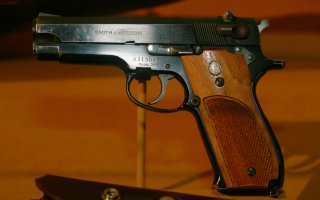Smith & Wesson's Model 39/59: Why This Old Gun Remains an American Legend
The Odyssey of the Smith & Wesson Model 39/59, from its Germanic origins to the gun shops of America and the jungles of Vietnam, was unique and very much a product of the Cold War.
Here's What You Need to Know: Although out of production and no longer common, Smith & Wesson’s nine-millimeter handgun has earned a noteworthy place in American firearms history.
One of the earliest American nine-millimeter pistols was adopted for wartime service to take out enemy sentries… and barking dogs.
The Smith & Wesson Model 39 semi-automatic handgun served U.S. Navy SEALs during the Vietnam War and then went on to become one of the American nine-millimeter high capacity pistols, the Model 59.
The Smith & Wesson Model 39 had its roots in postwar America. U.S. troops, encountering the Walther P-38 on the battlefield, had a favorable impression of the German pistol. U.S. gunmaker Smith & Wesson decided to make an Americanized version of the P-38 for the domestic market, and borrowed heavily from Walther’s design. Internally, the Model 39 was very similar, to the point where magazines could almost be swapped between guns. Externally there were key differences, including a 1911-type full barrel slide removed with a twist of a barrel bushing. The Model 39 went on commercial sale in 1955.
The Model 39 was a double action pistol. It was 7.44 inches long and weighed just 26.5 ounces empty with a four-inch barrel. It was a recoil-operated handgun using a modified version of the Colt/Browning locking system used on handguns such as the 1911. Like the Walther P-38 the slim metal, single stack magazine held eight rounds of 9-millimeter Parabellum.
During the 1960s the CIA had experimented on a suppressor for the Walther P-38, a pistol which in the Agency’s opinion combined reliability, firepower, and a distinctive non-American lineage. The suppressor greatly reduced the Walther’s report, particularly when combined with a slide lock that prevented the slide to fly backward. The use of a slide lock turned the pistol into a single-shot weapon and caused dramatic wear and tear on the handgun’s components, but the result was a very quiet pistol.
As the Vietnam War ramped up U.S. Navy SEALS requested a new suppressed pistol. The Naval Ordnance Laboratory picked the Smith & Wesson Model 39 and proceeded to adapt the CIA’s P-38 suppressor to it, including slide lock. The pistol used a heavy, full metal jacket 158 grain round developed with the assistance of Remington Arms. The extra weight slowed the normally supersonic 9mm round to below the speed of sound, eliminating the sharp crack of a bullet exceeding Mach 1.
The pistol’s imminent issue to SEAL units required it to be able to work after being transported through water. Plastic seals and muzzle plugs could seal off the suppressor from water and prevent water from entering the pistol barrel. The waterproofing was sufficient to protect the gun up to 200 feet underwater, both with the suppressor installed and without. The gun could be fired without removing the muzzle protection, which was blown off as the bullet exited the barrel.
The resulting weapon was given the Navy designation 9mm Pistol Mark 22 Mod 0. The weapon could be used by SEALs to covertly take out sentries guarding an enemy-held village or enemy stronghold, or even dogs that threatened to bark and reveal a SEAL unit’s presence. The Mark 22 Mod 0 received the nickname “Hush Puppy” for this reason.
The Model 39/Mark 22 was used by SEAL units throughout the Vietnam War. As the war wound Smith & Wesson turned its attention to updating the Model 39. The company’s designers went back to the drawing board and widened the grip, adding one of the first double-stack magazines ever on an American handgun. This nearly doubled magazine capacity to 14 rounds. While that may sound perfectly normal today, at the time six-round revolvers dominated the firearms scene and other semi-automatics carried a similar amount of rounds to the Model 39. The increased magazine size added only eight ounces to the weight of the pistol empty, in part due to the use of aluminum. The new pistol, called the Model 59, hit the U.S. domestic market in 1971.
The Odyssey of the Smith & Wesson Model 39/59, from its Germanic origins to the gun shops of America and the jungles of Vietnam, was unique and very much a product of the Cold War. Although out of production and no longer common, Smith & Wesson’s nine-millimeter handgun has earned a noteworthy place in American firearms history.
Kyle Mizokami is a writer based in San Francisco who has appeared in The Diplomat, Foreign Policy, War is Boring and The Daily Beast. In 2009 he co-founded the defense and security blog Japan Security Watch. You can follow him on Twitter: @KyleMizokami.
This article first appeared in 2019.
Image: Wikimedia Commons

